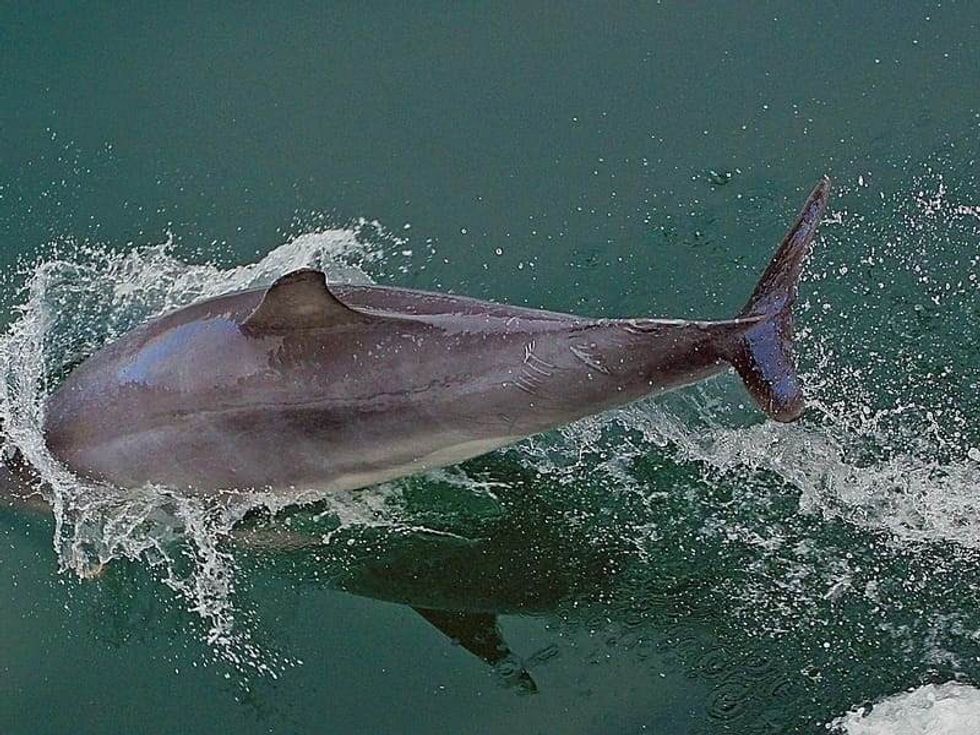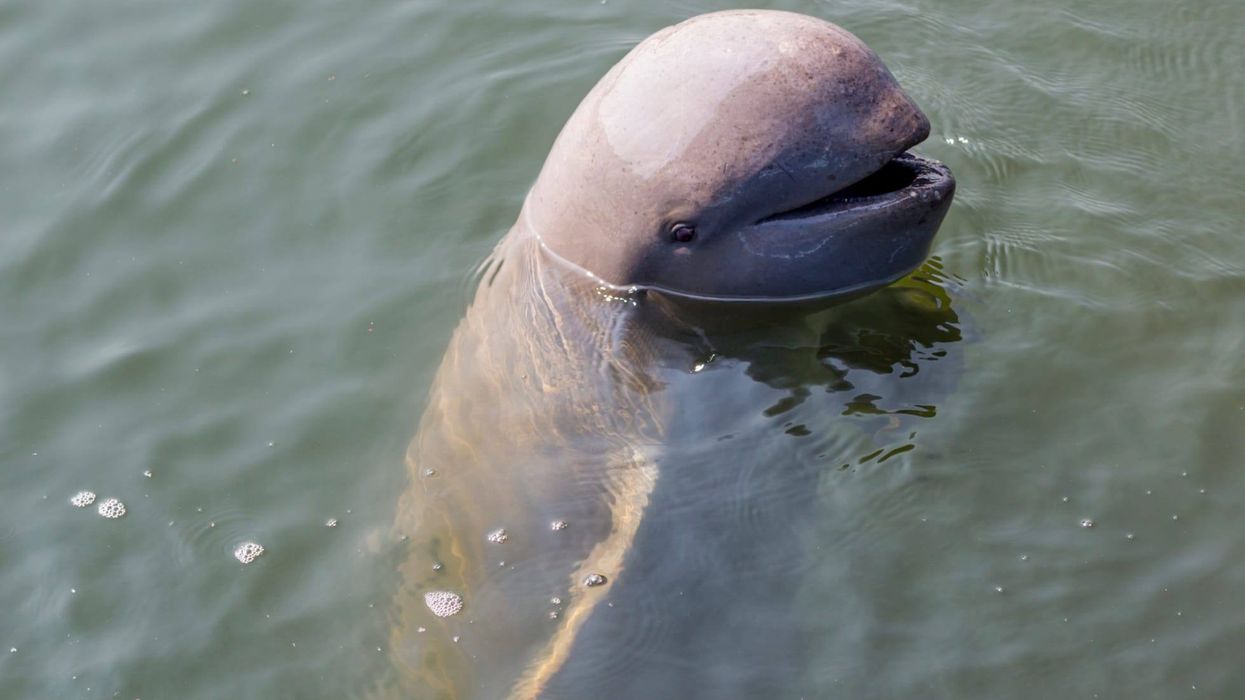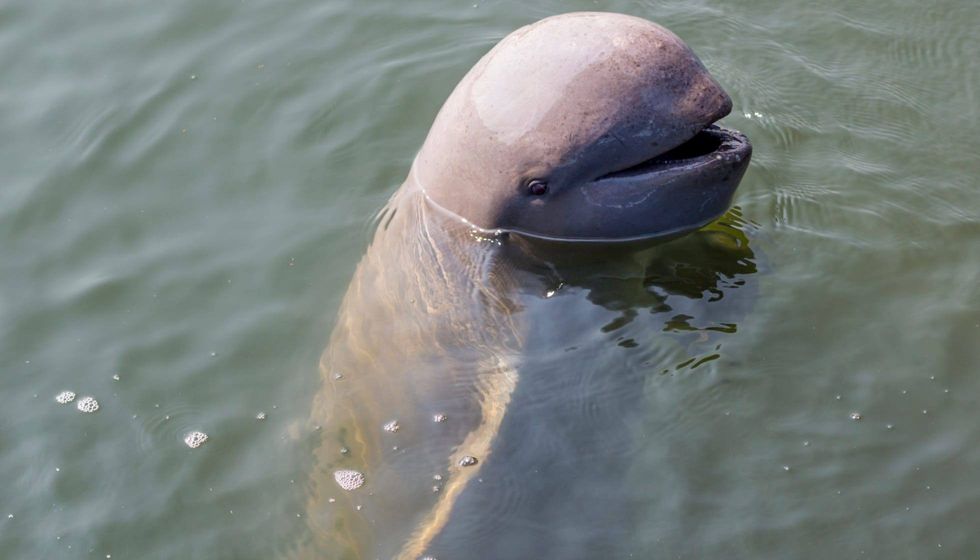Fun Irrawaddy Dolphin Facts For Kids

The Irrawaddy dolphins are a newly recognized species. Until 2005, it was believed to be the same as the Australian snubfin dolphin. Irrawaddy Dolphins have a charismatic nature with many expressive features.
A whale dolphin with a round-headed face and a short beak nose, they have a blueish to grayish color. They are found extensively in the Ayeyarwady River in Myanmar.
The Ayeyarwady River is known as the Irrawaddy River in English which gives these dolphins the name - Irrawaddy dolphins. Apart from this, these dolphins also inhabit Chilka Lake in India and parts of the Indo-Pacific region. They populate both marine and riverine water bodies.
They have a symbiotic relationship with fishermen in some colonies. The dolphins herd the fish towards the fishing net and get some of the catch in return.
The dolphins are identified by their peg-like teeth, movable lips, and creases on their neck that allow them to move it in all directions.
Irrawaddy river Dolphins (Orcaella brevirostris) have recently been listed in the list of Critically Endangered species. They come to the surface and unintentionally end up strangled in fishing nets cast in the Mahakam river, Irrawaddy River, Mekong River, and the Bay of Bengal.
In some parts of Asia, Irrawaddy Dolphins perform in front of the public in aquariums. Their act of spitting water into the air gives them popularity among people, especially children.
However, on the whole, they are shy aquatic creatures. If you want to know more about these migratory species of dolphins, we have collected all the interesting facts about the Irrawaddy dolphin, Orcaella brevirostris, their behavior, and their lifestyle!
For more similar content, check out Amazon river dolphin and Beluga whale facts.
Irrawaddy Dolphin Interesting Facts
What type of animal is an Irrawaddy dolphin?
Irrawaddy Dolphins (Orcaella brevirostris) belong to the euryhaline species of oceanic dolphins. They are shy aquatic mammals with a charismatic streamlined body and small dorsal fins. They are not whale dolphins, however, they look similar to baby belugas whales and the snubfin dolphins of Australia.
What class of animal does an Irrawaddy dolphin belong to?
The Irrawaddy Dolphins belong to the class of aquatic mammals or aquatic Mammalia.
How many Irrawaddy dolphins are there in the world?
The populations of Irrawaddy Dolphins are decreasing at an alarming rate and currently, there are less than 7,500 dolphins in the world. The Chilka Lake is believed to have around 146 of them.
Where does an Irrawaddy dolphin live?
Irrawaddy Dolphins (Orcaella brevirostris) live in oceans and in freshwater bodies.
What is an Irrawaddy dolphin's habitat?
Irrawaddy dolphins belong to the parts of South and Southeast Asia. They can be located in freshwater bodies like rivers, lakes, and estuaries.
The freshwater populations of Irrawaddy dolphins live close to the coastal areas of the Bay of Bengal, New Guinea, and Lao Pdr. They like to slow swim while observing the surroundings around them.
Also, they live in the water bodies like the brackish water of Chillika lake in India and Songkhla lake of Thailand. The Irrawaddy dolphin habitat is constantly threatened due to climate change and overfishing.
Who do Irrawaddy dolphins live with?
Irrawaddy Dolphins live in patches of four to five dolphins. They like to stay in sheltered river deltas close to human civilization where fishermen live.
They help them to catch fishes by driving large schools of fishes towards their gill nets and then tap the sides of their boats. Sometimes, groups of as large as 15 members and as low as two members have been found.
The Irrawaddy dolphin habitat does not change i.e. they prefer to remain in the same location like a mangrove forest with an established social circle.
How long does an Irrawaddy dolphin live?
Irrawaddy Dolphins have a lifespan of approximately 30 years. However, the oldest living Irrawaddy Dolphin lived for 28 years. They generally live in brackish waters such as the Mangrove forest of Bangladesh.
How do they reproduce?
The Irrawaddy Dolphin reproduces in the age span of three to nine years. They give birth to one calf every couple of years.
It is observed that mating happens between December to June and the birth period lies between June to August. These dolphins are found to mate outside of their own groups. It is believed that the male of the species endeavors to impress the female and often mates with multiple females.
The gestation period is nine months. However, in the case of captive dolphin, it was found to last as long as 14 months.
What is their conservation status?
The IUCN currently classifies Irrawaddy dolphins as 50% Vulnerable and 50% Endangered. As they live close to coastal areas, they do not have natural aquatic predators such as male sharks.
However, threatened by human activity, they protect themselves by virtue of their social bonds. They use their social circle to hit or agitate predators and drive them away.
The hunchback helps them to hit any predator who comes too close. The low reproduction rate and human activities are the main threat to the declining status.
They also suffered greatly during various wars and fishing expeditions carried out during the 1970s. As most dolphins live in river mouths that are populated by humans, they are greatly affected by waste and chemicals released into the sea.
Currently, they have acquired endangered status and there are many organizations that monitor the water levels in their habitat zones. Overfishing has caused a decrease in the number of crustaceans and smaller fishes which are the primary food source for Irrawaddy dolphins.
There is a danger of extinction and dolphin conservation is a must need to save them. You can help in the conservation of Irrawaddy dolphins by 'adopting' one symbolically via a conservation society like the WWF (World Wide Fund for Nature).
Here, you pay a certain amount for the organization to look into the upkeep of the animal.
Another way is by looking into the conservation commissions of your own country. Some countries like Cambodia have set up a Dolphin Commission with protection rager officers to take care of the animals.
Dolphins in the Mahakam River in Indonesia are also protected by conservation laws. If Irrawaddy dolphins are found to be extinct then it could disrupt the natural ecosystem of the ocean and result in an abundance of their prey (mollusks and fishes).
Irrawaddy Dolphins Fun Facts
What do Irrawaddy dolphins look like?
The Irrawaddy dolphins are instantly recognizable by their rounded head. They have a plain gray to grayish-blue color with a lighter underbelly. Irrawaddy dolphins look quite similar to Beluga whales, but the two are not related.

How cute are they?
Because of their rounded heads and small fins, these dolphins look extremely cute and friendly! Their curved lips give them a perpetually smiling expression with beady and expressive eyes crowning their head.
They have an acrobatic and streamlined body and cut smoothly through the water. They are notorious, cheeky, and sometimes even called mysterious by the photographers trying to capture images of them.
How do they communicate?
The Irrawaddy dolphins communicate via echolocation. These sounds range in a frequency of around 60 kHz and cannot be picked up by a human ear.
Different dolphins use different vocal pitches which others can use to distinguish individuals. Apart from this, they also bump into each other and flip their tails as indications. During the mating seasons, males may also bump against each other's heads as a form of aggressive behavior to signify territory.
They may gently graze against each other's fins to show affection. They do not use any vocal signals.
Their preferred communication language consists of buzzes, clicks, whistles, and creaks. Whistles are useful in communicating with other dolphin species. To hear the signals, Irrawaddy dolphins have a sound conducting tissue located in their jaw.
They do not have external ears or auditory canals. A well-known sight is of these dolphins leaping out of the water to indicate joy or simply looking out for predators.
How big is an Irrawaddy dolphin?
The Irrawaddy dolphin length can range from 5ft 9 in - 9ft 1 in.
How fast can an Irrawaddy dolphin swim?
Mahakam river dolphins can swim at a speed ranging between 20-25 mph when feeling threatened or chased by a predator. However, for other times they are slow swimmers that occasionally leap out of water.
How much does an Irrawaddy dolphin weigh?
The Orcaella brevirostris (Irrawaddy Dolphin) can weigh in between 198-400 lb (90-200 kg).
What are their male and female names of the species?
The name of male and female species of Mekong river Irrawaddy dolphins are Orceaella brevirostris and Orceaella heinsohni respectively.
What would you call a baby Irrawaddy dolphin?
The female Irrawaddy dolphins undergo a gestation period of about 14 months and give birth to their young ones called calves.
What do they eat?
The coastal Irrawaddy dolphin diet consists mainly of carnivore foods like cephalopods, fish, crustaceans, and fish eggs. They live in a pack of 6-15 Irrawaddy dolphins and spit water to attract small fishes.
They hit large animals with their rounded head to play before consuming their food. This species of wild dolphin living in coastal waters feed upon the remaining fishes that get stuck in the bottom of the seabeds while strangled in the fishing gear. The Irrawaddy dolphin habitats and prey are under threat due to global warming.
Are they friendly?
The Irrawaddy dolphins, Orcaella brevirostris, of the Irrawaddy River (Myanmar) have a friendly nature. They help fishers herd fish by driving the fishes towards the gill net laid out for fishes in the water bodies.
Would they make a good pet?
Irrawaddy dolphins have charismatic and friendly nature. Therefore, they have become a vital source of eco-marine tourism in Asia and Southeast Asia.
They have become a source of stable income for most of the communities involved in eco-tourism. The dolphins perform as the show stopper of many aquatic shows due to their high spirit and smiling faces. However, they are not meant to be pets.
While they are portrayed as friendly animals, like any wild and predatory animals, Irrawaddy dolphins can be aggressive. They have been known, at times to attack humans.
Did you know...
The Irrawaddy Dolphin can submerge their body into deep water for more than six minutes. However, they take time of about one to two minutes for diving.
Contrary to popular belief, Irrawaddy dolphins spend most of their time underwater and very rarely come up to the surface. They are social creatures and enjoy living in small groups. They are also location-specific and do not follow any migratory routes.
The Irrawaddy Dolphin has been listed as the unique and only existing species of the Orcaella genus.
The Irrawaddy Dolphin population has become a vital point of discussion as to whether one would place them in the list of Monodontidae or in Delphinapteridae.
The Irrawaddy dolphins have 12-19 peg-like teeth on each side of the jaws - a unique and identifiable trait.
The Irrawaddy Dolphin (Orcaella brevirostris) is worshipped by the groups of Khmer and Lao people. In Ancient China, they were worshipped as the Goddess of the Yangtze River.
The Irrawaddy Dolphin (Orcaella brevirostris) was first described in 1866 by a specimen in the Vishakhapatnam Harbor (in the present-day east coast of Andhra Pradesh).
How much does an Irrawaddy dolphin weigh when born?
The Irrawaddy Dolphin newly born weighs approximately 22 lb (10 kg).
How do Irrawaddy dolphins hunt?
The Irrawaddy species of dolphins hunt in groups. These groups can have as low as five members or as many as 13 members.
The Irrawaddy dolphin diet consists of smaller fishes and they herd them by spitting water at a distance of up to 5 ft. In this way, they can attract more fishes towards themselves.
The Irrawaddy dolphin adaptations include a hunchback. They hit prey with their rounded hunchback before consuming them. Sometimes, this way of hitting with the hunchback is also considered as playing with their prey.
Sometimes, it is seen that they herd fishes towards a fisherman's net as well. These 'tamed' Mekong River dolphins work together with the fishermen who then give a portion of the haul to the dolphins.
Here at Kidadl, we have carefully created lots of interesting family-friendly animal facts for everyone to discover! Learn more about some other mammals including the common dolphin, or spinner dolphin.
You can even occupy yourself at home by drawing on our dolphin coloring pages.
We Want Your Photos!
More for You
See All
Bachelor of Arts specializing in Journalism and Mass Communication, Postgraduate Diploma in Sports Management

Moumita DuttaBachelor of Arts specializing in Journalism and Mass Communication, Postgraduate Diploma in Sports Management
A content writer and editor with a passion for sports, Moumita has honed her skills in producing compelling match reports and stories about sporting heroes. She holds a degree in Journalism and Mass Communication from the Indian Institute of Social Welfare and Business Management, Calcutta University, alongside a postgraduate diploma in Sports Management.
Bachelor of Journalism and Mass Communication

Ambuj TripathiBachelor of Journalism and Mass Communication
Ambuj is a skilled fact checker with a Bachelor's degree in Journalism and Mass Communication from Amity University. He has been recognized for his exceptional content writing skills, having won a CineMedia competition. In addition to his writing abilities, he also has a flair for design.
Disclaimer
1) Kidadl is independent and to make our service free to you the reader we are supported by advertising. We hope you love our recommendations for products and services! What we suggest is selected independently by the Kidadl team. If you purchase using the Buy Now button we may earn a small commission. This does not influence our choices. Prices are correct and items are available at the time the article was published but we cannot guarantee that on the time of reading. Please note that Kidadl is a participant in the Amazon Services LLC Associates Program, an affiliate advertising program designed to provide a means for sites to earn advertising fees by advertising and linking to Amazon. We also link to other websites, but are not responsible for their content.
2) At Kidadl, we strive to recommend the very best activities and events. We will always aim to give you accurate information at the date of publication - however, information does change, so it’s important you do your own research, double-check and make the decision that is right for your family. We recognise that not all activities and ideas are appropriate for all children and families or in all circumstances. Our recommended activities are based on age but these are a guide. We recommend that these ideas are used as inspiration, that ideas are undertaken with appropriate adult supervision, and that each adult uses their own discretion and knowledge of their children to consider the safety and suitability. Kidadl cannot accept liability for the execution of these ideas, and parental supervision is advised at all times, as safety is paramount. Anyone using the information provided by Kidadl does so at their own risk and we can not accept liability if things go wrong.
3) Because we are an educational resource, we have quotes and facts about a range of historical and modern figures. We do not endorse the actions of or rhetoric of all the people included in these collections, but we think they are important for growing minds to learn about under the guidance of parents or guardians.







